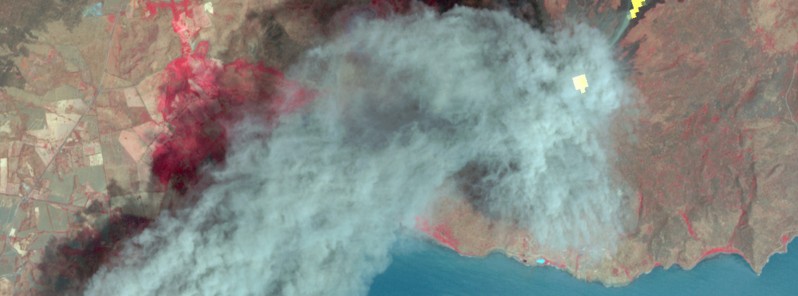ASTER Earth imagery now available at no cost

Beginning April 1, 2016, all Earth imagery from a prolific Japanese remote sensing instrument – ASTER – operating aboard NASA's Terra spacecraft since late 1999 is now available to users everywhere at no cost.
The public will have unlimited access to the complete 16-plus-year database for Japan's Ministry of Economy, Trade and Industry (METI) Advanced Spaceborne Thermal Emission and Reflection Radiometer (ASTER) instrument, which images Earth to map and monitor the changing surface of our planet. ASTER's database currently consists of more than 2.95 million individual scenes. The content ranges from massive scars across the Oklahoma landscape from an EF-5 tornado and the devastating aftermath of flooding in Pakistan to volcanic eruptions in Iceland and wildfires in California.
ASTER is used to create detailed maps of land surface temperature, reflectance, and elevation. The instrument acquires images in visible and thermal infrared wavelengths, with spatial resolutions ranging from about 15 to 90 meters (50 to 300 feet). ASTER data cover 99 percent of Earth's landmass and span from 83 degrees north latitude to 83 degrees south. A single downward-looking ASTER scene covers an area on the ground measuring about 60-by-60-kilometers (37-by-37 miles).
ASTER uses its near-infrared spectral band and downward- and backward-viewing telescopes to create stereo-pair images, merging two slightly offset two-dimensional images to create the three-dimensional effect of depth. Each elevation measurement point in the data is 30 meters (98 feet) apart.
The broad spectral coverage and high spectral resolution of ASTER provide scientists in numerous disciplines with critical information for surface mapping and monitoring of dynamic conditions and changes over time. Example applications include monitoring glacial advances and retreats, monitoring potentially active volcanoes, identifying crop stress, determining cloud morphology and physical properties, evaluating wetlands, monitoring thermal pollution, monitoring coral reef degradation, mapping surface temperatures of soils and geology, and measuring surface heat balance.
"We anticipate a dramatic increase in the number of users of our data, with new and exciting results to come," said Michael Abrams, ASTER science team leader at NASA's Jet Propulsion Laboratory in Pasadena, California, home to ASTER's U.S. science team. ASTER data are processed into products using algorithms developed at JPL and the National Institute of Advanced Industrial Science and Technology (AIST) in Japan. A joint U.S./Japan science team validates and calibrates the instrument and data products.
ASTER data are now available via electronic download from NASA's Land Processes Distributed Active Archive Center (LP DAAC) at the U.S. Geological Survey's (USGS) Earth Resources Observation and Science Center in Sioux Falls, South Dakota, and from AIST.
To access the data, visit:
https://lpdaac.usgs.gov/dataset_discovery/aster or https://gbank.gsj.jp/madas/
Featured image: In March 2016, ASTER captured the eruption of Nicaragua's Momotombo volcano with its visible and thermal infrared bands. The ash plume is depicted by the visible bands in blue-gray; the thermal infrared bands show hot lava flows in yellow and the active summit crater in white. Vegetation is red. Credit: NASA/GSFC/METI/ERSDAC/JAROS, and U.S./Japan ASTER Science Team

suddenly relaised that this news paper is much bigger then local news paper. news from ASTER is amazing i would like to get it on my e mail regularly thanks